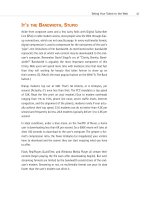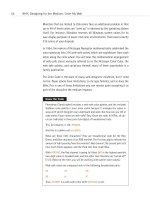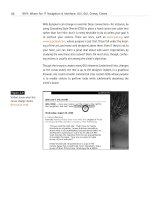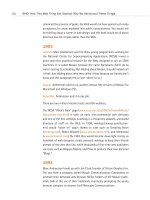Taking Your Talent to the Web: A Guide for the Transitioning Designer- P8 pptx
Bạn đang xem bản rút gọn của tài liệu. Xem và tải ngay bản đầy đủ của tài liệu tại đây (169.69 KB, 20 trang )
Netscape goes open source, unveiling the secrets of its code in the hopes
that thousands of programmers around the world will join together to cre-
ate a newer, better version of the Netscape browser. The open source proj-
ect for the Netscape Navigator source code is named Mozilla. The
Department of Justice begins an antitrust lawsuit against Microsoft.
1999
America Online (AOL), though partially responsible for the growth and pop-
ularity of the Web, has long been despised by Internet connoisseurs. Many
holding this view are die-hard Netscape users, who see AOL as a propri-
etary service for frightened “newbies” (neophyte Internet users). In a move
that shocks the online world, AOL buys Netscape.
Netscape announces that its upcoming 5.0 browser, being built by
the Mozilla open source project, will fully support the five key stan-
dards demanded by The Web Standards Project (www.webstandards.org
/mission.html). The 5.0 browser never sees the light of day, but in late 2000
the project and Netscape will give birth to Netscape Navigator 6.
Microsoft announces that its upcoming 5.0 browser for the Mac will fully
support two key web standards and offer “90 percent support” for others.
At least 100,000 web-related jobs cannot be filled because of lack of qual-
ified personnel. Populi, the Web Talent Incubator, is launched to solve this
problem. Your humble web author, who appears to enjoy typing the phrase
“your humble web author,” will later help Populi develop a curriculum in
web communication design, which will still later become the basis for the
book you are now reading, which will yet later be unearthed by archeolo-
gists of the thirty-first century, along with a Pepsi bottle.
2000
The year web standards broke, 1
Internet Explorer 5, Macintosh Edition is released in March, offering
near perfect support for HTML 4, CSS-1, and JavaScript
(www.alistapart.com/stories/ie5mac/).
121
Taking Your Talent to the Web
07 0732 CH04 4/24/01 1:02 PM Page 121
The year web standards broke, 2
Netscape 6 is released in the wee hours of November 14. It supports XML,
and the W3C DOM as well as the standards supported by IE5/Mac.
The year web standards broke, 3
Opera 5 (www.opera.com), released in December, supports HTML, CSS, XML,
WML, ECMAScript, and the DOM (www.opera.com/opera5/specs.html).
The year the bubble burst
A number of ill-conceived web businesses fail, causing the usual dire
predictions and market panics. A number of good web businesses
are dragged down along with the unworthy ones. Overbuilt web agencies
lay off staff; other agencies absorb them.
2001
You buy this book. And buy a second copy for a friend. And a third for your
coffee table.
122
WHO: How This Web Thing Got Started: Why We Mentioned These Things
07 0732 CH04 4/24/01 1:02 PM Page 122
chapter 5
The Obligatory Glossary
SEVERAL YEARS BACK, Grey Advertising, Inc. felt it was perceived as a some-
what lackluster agency: large, dependable, and successful at delivering
results, but not exactly cutting-edge in a world of Chiats and Weiden-
Kennedys (the people who have made commercials for Apple and Nike).
Grey wanted to enhance its image, and as companies often do, it brought
in an outside consultant. A depressing sum of money later, the consultant
unveiled this recommendation: make the logo orange. A Grey company
with an orange logo, get it? Unexpected. Cutting edge. Fresh. Or so the con-
sultant argued, and the agency apparently agreed.
The story may be apocryphal, we hasten to add, because Grey has more
lawyers than our publisher. We mention the whole thing because, as if
Internet terminology itself weren’t confusing enough, job nomenclature at
web agencies can be dazzlingly baffling. This is thanks, in part, to consult-
ants who think an orange Grey makes an Apple and “user experience trans-
actional information architect” sounds better than “designer.”
The Web is an insanely great medium. The young industry is exciting
and challenging enough to fulfill you through a dozen lifetimes, but the
business is so new that even people who work in it get confused over
terminology.
08 0732 CH05 4/24/01 11:18 AM Page 123
Some companies have a dozen different titles for designers with slightly
different jobs; other companies slap one title on everybody, and often
enough the title makes little intuitive sense. Orange you Grey we’ve pro-
vided this little chapter to help you navigate the twin minefields of Inter-
net buzzwords and ever-changing job titles? You bet you are. (Our
apologies to Grey Advertising, consultants everywhere, and People for the
Ethical Treatment of Animals, whom we haven’t offended but just felt like
mentioning because it’s a good cause. Besides, if we don’t mention it here,
our cats will claw our eyes out—and they can do it.)
WEB LINGO
Extranet
An extranet is a private network of computers that is created by connect-
ing two or more intranets or by exposing an intranet to specific external
users and no one else. Business-to-business collaboration often uses
extranets.
In English: Extranets are websites that allow Company A to interact with
Company B, and Special Customer C to interact with either or both—pretty
kinky stuff. As a web designer, you may never be called upon to design an
extranet. (If you are, it’s the same thing as designing a website. We’re sorry
to bore you with these tedious distinctions, but that’s our job in a section
like this. We hear the American Movie Classics cable network is hosting an
Alfred Hitchcock retrospective. Maybe you should go watch it until this
chapter blows over.)
On the other hand, the Business-to-Business (B2B) category is one of the
largest growth areas of the Web, so you may find yourself stuck, er, asked
to design extranet sites anyway.
Websites are websites whether they’re designed for the general public or
for private businesses. However, because extranets are business-oriented,
they tend to be more like software and less like magazines or television. In
other words, the challenges are closer to industrial design and technical
design and further from the consumer-oriented design many of us are used
124
WHO: The Obligatory Glossary: Web Lingo
08 0732 CH05 4/24/01 11:18 AM Page 124
to. In still other words, this type of design work is not for everybody, though
some designers adore and excel at it. (Excel is a trademark of Microsoft,
and even though we didn’t use it in that context in the preceding sentence,
their lawyers read everything.)
HTML
Hypertext Markup Language (HTML) is an application of Standard Gener-
alized Markup Language (SGML) and is used to construct hypertext docu-
ments (web pages).
In English: HTML is to web pages what PostScript is to print. But while Post-
Script is a complex programming language, best handled behind the scenes
by software such as Illustrator and Quark XPress, HTML is a simple markup
language best written by human beings. HTML breaks content down into
structural components, much as an outline does.
The simplicity of HTML makes it easy to learn, but that simplicity also can
be limiting. Soon, many sites will be built with more advanced tools, such
as Extensible Markup Language (XML). You need not concern yourself with
that now. Later on in this book we will show you what HTML is, how to use
it correctly, and how to employ it creatively. See Chapter 8, “HTML: The
Building Blocks of Life Itself.”
Hypertext, hyperlinks, and links
For additional information, refer to the section titled, “Website” later in this
chapter.
Internet
The Internet is a worldwide networking infrastructure that connects all
variety of computers together. These connections are made via Internet
protocols including (surprise, surprise) Internet Protocol (IP), Transport
Control Protocol (TCP), and User Datagram Protocol (UDP). IP is used for
addresses, TCP is used to manage sockets (and hence the Web), and UDP is
used to manage Domain Name Servers (DNSs). See Chapter 4, “How This
Web Thing Got Started,” for further explanation.
125
Taking Your Talent to the Web
08 0732 CH05 4/24/01 11:18 AM Page 125
In English: The Internet is to the Web as cable networks are to television
or as phone cables and switching stations are to your Uncle Marvin, who
always phones while you’re away on vacation and then resents you for not
returning his call the very next day. The Internet is a combination of hard-
ware (computers linked together) and software (languages and protocols
that make the whole thing work).
As a web designer, all you need to keep in mind is that you’re not only com-
municating with readers and viewers (“users” if you must), you’re also cre-
ating work that must fit into formats appropriate to Internet technology.
In other words, it’s not your job to manage networks (for instance) as long
as you understand their implications for your work—such as bandwidth and
cross-platform issues. See Chapter 2, “Designing for the Medium.”
Intranet
An intranet is an internal or private networking infrastructure that uses
Internet technologies and tools. Unlike what occurs on the Internet, only
computers on the private physical network can access an intranet.
In English: As a web designer, in addition to creating sites for the public,
you also might be called upon to create intranet sites, which are nothing
more than websites for private companies. For instance, AT&T not only has
websites for the public, it also has thousands of private intranet sites where
its employees can communicate with each other, schedule appointments,
keep track of company policies, and so on.
One other difference worth noting is that when you’re designing an Inter-
net site, it has to be usable by anyone in the world—Netscape, Opera, IE,
and iCab users; 6.0 browser users as well as 2.0 browser users; the blind
and the not-blind; WebTV users and AOL users alike. You get the picture.
On an intranet site, by contrast, all visitors may be using the same web
browser and computing platform, which can simplify some of your design
choices.
Of course, even in such circumstances, it is best to design with open stan-
dards so that your client will not be locked into restrictive choices. For
instance, if you had designed an intranet for a network of Netscape 4 users
126
WHO: The Obligatory Glossary: Web Lingo
08 0732 CH05 4/24/01 11:18 AM Page 126
in 1998, you might have built the entire site using Netscape’s proprietary
LAYERS technology. But with Navigator 6, Netscape stopped supporting
LAYERS in favor of W3C standards. Had you designed specifically for
Netscape’s previous browser, your site would not work when the client
upgraded browsers. Clients dislike that sort of thing, even when they are
the ones who insisted on using a specific technology. Proceed with caution.
Additionally, if all the site’s users are connected via a local network, you
can make bold use of bandwidth-intensive technologies such as streaming
video. When designing for the Web, you need to worry about bandwidth.
Full-screen video is out; smaller video images and heavily compressed
audio might be okay. For more on this fascinating topic, see Dave Linabury’s
“The Ins and Outs of Intranets” at www.alistapart.com/stories/inout/.
JavaScript, ECMAScript, CSS, XML, XHTML, DOM
In English: Additional languages of the Web.
Briefly: JavaScript is a programming language that enables designers or
developers to build dynamic interactivity into their sites, further separat-
ing the Web from print. ECMAScript is a standardized version of JavaScript.
See Chapter 11, “The Joy of JavaScript,” for more particulars on this topic.
Cascading Style Sheets (CSS) is a standard that enables designers to con-
trol online layout and typography. Like HTML, its basics are extremely easy
to learn, though its subtleties elude many designers (as well as many
browsers). See Chapter 10, “Style Sheets for Designers.”
XML is a simplified version of SGML, designed for use on the Net. As of this
writing, it is most often used to deliver database-independent query results
between incompatible software applications. It is not yet universally sup-
ported in web browsers, though XML 1 is fully supported in Netscape 6, and
much of it is supported in IE5 and Opera 5. As a web designer, at least for
the next few years, you will hear about and see XML, but you will not be
called upon to create it—unless you begin marking up your web pages in
Extensible Hypertext Markup Language (XHTML).
127
Taking Your Talent to the Web
08 0732 CH05 4/24/01 11:18 AM Page 127
XHTML is essentially an XML version of HTML that works in most browsers.
It is currently the W3C-recommended markup language for creating sites,
though most sites as of this writing are still created in HTML. The differ-
ences between HTML and XHTML, from the “writing the code” point of
view, are rather small, like Japan, though the implications of XHTML are
rather large, like China.
The Document Object Model (DOM) is a web standard that lets these other
standards “talk to each other” to perform actions. (For more about this, see
Chapter 11.)
With the increasing specialization of the Web, designers are no more
expected to master all these technologies than Rabbis are expected to fry
bacon. Web designers should learn CSS (which is easy), and most learn
enough JavaScript to be dangerous. Developers rather than designers will
likely do the XML and DOM programming as well as most of the heavy-duty
JavaScript/ECMAScript. The longer you work in the field, the more knowl-
edgeable you will become about these standards, but few employers will
expect you to have more than rudimentary awareness of most of this stuff.
Web page
As explained in Chapter 1, “Splash Screen,” a web page is a type of elec-
tronic document, just as a Microsoft Word file or a Photoshop document
is, except that a web page does not require any particular brand of soft-
ware for someone to open and/or use it. And that is the glory of it, broth-
ers and sisters. Developers and designers build web pages in HTML but, as
noted above, they also use stuff besides HTML, which we’ll talk about in
the relevant technical chapters.
Website
A website is a collection of related web pages published on the World Wide
Web.
In English: Click here.
128
WHO: The Obligatory Glossary: Web Lingo
08 0732 CH05 4/24/01 11:18 AM Page 128
Additional terminology
Tech terms will come up like last night’s chili burritos throughout your
career. You can always look up the latest buzzwords (or refresh your mem-
ory about what you have learned) by turning to the Computer Currents
High-Tech Dictionary at www.currents.net/resources/dictionary/.
ROLES AND RESPONSIBILITIES IN THE WEB
WORLD
As a web designer, you will be responsible for creating the look and feel of
websites—or portions thereof. Web designers may create menu bar icons
for sites designed by other designers on their team, or they may create ani-
mated ad banners for sites designed by others. Hey, you’ve read Chapters
2 and 3—you know the deal. (If you don’t, read the next chapter, which
describes the web designer at painful length.) Meanwhile, this seems as
good a place as any to familiarize yourself with some of the other players
on your team.
Web developer/programmer
The web developers on your team will be responsible for the technical
implementation of the site. You might hear them talk about Perl, Java, ASP,
PHP, SSI, XML, ColdFusion, and other technologies. Just smile and nod as if
you get it.
Most sites seamlessly fuse design, content, and interactivity. For that to
happen, teamwork is needed. You don’t have to understand how develop-
ers work their magic any more than developers need to possess design or
writing skills. But thoughtful collaboration and mutual respect for each
other’s disciplines are required to create functionally and aesthetically
superb sites.
Many developers have their roots in UNIX. Some are old hippies; others look
like preteen rejects from the cast of The Matrix. With the frantic need for
qualified personnel, developers also might come from the ranks of tradi-
129
Taking Your Talent to the Web
08 0732 CH05 4/24/01 11:18 AM Page 129
tional information technology (IT) services. Many of these people are won-
derful, but some have a strong bias toward particular technologies and
generally do not approach web development with a “Webby” mindset—by
which we mean a preference for open standards and accessibility.
For instance, IT-trained developers with roots in Microsoft-only shops
sometimes employ technologies that leave Mac, Linux, UNIX, and OS/2
users out in the cold. This is because they don’t know any better; they are
as trapped by their training as that sad little boy who shoots puppies. (We
now make good on our earlier apology to People for the Ethical Treatment
of Animals. You see, this book is really very skillfully woven together in spite
of its strange, dreamlike quality.)
Before accepting a job, be sure to check the company’s offerings using at
least one of these non-Windows operating systems. If the sites fail, the
developers may be biased in favor of proprietary technologies without real-
izing the harmful nature of that predisposition.
Designers who wish their work to reach the broadest possible audience
might want to think twice before accepting a job at a place like that. We’ve
even seen shops where Mac-using designers can’t send email due to Win-
dows-only gateway issues. This is not intended as a slam at Microsoft’s
many fine products, two of which were used in the creation of this book.
It is simply cautionary advice for the job seeker. In our opinion, because
closed systems lock out millions of potential users, serious web developers
prefer open standards.
Project manager
These team members are like technologically savvy account executives.
They help articulate the client’s needs, develop schedules (timelines) and
budgets, and are responsible for keeping the project on track. Just like the
account executives you might have worked with in your traditional design
career, project managers are usually good people with stressful jobs. As you
used to do with account executives, you must employ tact and patience to
negotiate with these folks.
Project managers will often produce things called Gantt Charts, which are
frankly little more than fancy work schedules. Say “thank you” when you
get these. It makes them feel good about themselves.
130
WHO: The Obligatory Glossary: Roles and Responsibilities in the Web World
08 0732 CH05 4/24/01 11:18 AM Page 130
Do not actually look at the Gantt Charts, however. They will only frighten
you and make you feel hopeless and uncreative. Don’t worry about missing
any deadlines. The project managers will be “casually dropping by” your
cubicle every 15 minutes for the next 40 years, and you won’t miss a sin-
gle deadline. See, what did we tell you? They’re exactly like account
executives.
Systems administrator (sysadmin) and network
administrator (netadmin)
Sysadmins and netadmins are also called network engineers, database
administrators, directors of web development, webgods, UNIX guys, NT
guys, Linux guys, and geeks (formerly often called “webmasters”)—these
are the people who run the server (computer) that houses the site you’re
developing. They also run the staging server where you might build the site
before actually “publishing” it to the Web.
In some companies these folks are woefully underpaid juniors with exten-
sive computing knowledge. In others, they’re woefully overpaid juniors
without any computing experience at all, which is why many old-school
webmasters now call themselves systems administrators, network engi-
neers, database administrators, and so forth, leaving the webmaster
moniker to the temp who answers email about the site.
Most sysadmins are senior employees in charge of a staff. In small compa-
nies, they also might be the folks you go to when you need software
installed on your computer or if you’re having trouble with your email. In
larger companies, an IT person typically handles those responsibilities. In
some companies, sysadmins are also developers and in others, they are not.
Some companies call their sysadmins developers. Some call their juniors
seniors—because titles are easier to come up with than salary. Some say
love is like a flower. Don’t let any of this drive you mad. Above all, respect
the sysadmins. Without them, we’d have no Web.
Web technician
Web technicians, also called producers, web producers, HTML jockeys, web-
monkeys, web practitioners, HTML practitioners, design technicians, HTML
technicians, geeks, and many other things, are folks who do a job similar
to that of the studio people in an ad agency. As studio people take an art
131
Taking Your Talent to the Web
08 0732 CH05 4/24/01 11:18 AM Page 131
director’s comp and make technologically-oriented changes to it so that it
can be handed off to a printer, web technicians take a web designer’s Pho-
toshop comp, cut it apart, and render it in HTML, JavaScript, and other lan-
guages as needed. They also will render the graphic elements in
web-appropriate formats.
If you were wondering, the difference between web technicians and web
developers is largely a matter of experience, knowledge, and salary. A web
technician may cut your comp apart and write HTML; a web developer is
more like a technology designer who envisions powerful transactions and
writes advanced code in several different languages to bring those visions
to life.
Web developers are as critical to the process as lead designers, whereas
web technicians are more like junior designers. Junior designers might cre-
ate buttons or develop alternate color schemes under the supervision of a
senior designer; similarly, web technicians generally do lower-level pro-
gramming tasks than web developers. Some don’t program at all but sim-
ply use cut-and-paste JavaScripts (as do many web designers).
In smaller companies (or in large companies when there is a time crunch),
there are no web technicians; web designers execute their own designs in
HTML, JavaScript, and other languages as needed. This book will prepare
you to do that part of the job, making you that much more employable and
giving you that much more control over the process. (And as designers, we
all like control.)
Even if you always work in large companies, your knowledge of these
processes will enable you to work closely with web technicians, often in a
supervisory capacity—as if they were junior designers helping you execute
your campaign. It also will enable you to self-publish your creative work if
you find, as many of us do, that the Web is the greatest thing since sliced
bread, and you have an urge to do creative work even after hours.
We started this chapter by mentioning that titles are often confusing in
this business. The same thing holds for job responsibilities. While there are
plenty of junior and mid-level web technicians, there are also web devel-
opers who handle these tasks. Regardless of anyone’s stature, it goes with-
out saying that you should be respectful to all your teammates because
that makes life better.
132
WHO: The Obligatory Glossary: Roles and Responsibilities in the Web World
08 0732 CH05 4/24/01 11:18 AM Page 132
And speaking of you…
YOUR ROLE IN THE WEB
Will be covered in the very next chapter. Go there.
133
Taking Your Talent to the Web
08 0732 CH05 4/24/01 11:18 AM Page 133
08 0732 CH05 4/24/01 11:18 AM Page 134
chapter 6
What Is a Web Designer,
Anyway?
WE’VE EXPLORED THE STRENGTHS AND LIMITATIONS of the Web as a unique
medium; considered architecture and navigation as key components of the
user experience; glanced at the medium’s history; defined technical terms;
and examined the roles played by your coworkers. Maybe it’s time to look
at your job on the Web. We’ll start with a working definition.
Definition
Web designers are professionals who solve a client’s communication problems
and leverage the client’s brand identity in a web-specific way.
Complementing this focus on the client’s needs, web designers must think like
the site’s anticipated audience. They foresee what visitors will want to do
on the site and create navigational interfaces that facilitate those needs.
Pretty dry stuff, we’ll grant you, but like marital bliss, it’s better than it
sounds.
How does all this fancy talk break down in terms of daily tasks? Below is a
summary of deeds you’ll do during the web development project life cycle.
In Chapter 7, “Riding the Project Life Cycle,” we delve into details.
09 0732 CH06 4/24/01 11:18 AM Page 135
Through the project life cycle, the web designer will need to:
■ Understand and discuss the underlying technology—its possibilities
and limitations as well as related issues—with clients and team
members.
■ Translate client needs, content, and branding into structured web-
site concepts.
■ Translate projected visitor needs into structured website
concepts.
■ Translate website concepts into appropriate, technically
executable color comps.
■ Design navigation elements.
■ Establish the look and feel of web pages, including typography,
graphics, color, layout, and other factors.
■ Render design elements from Photoshop, Illustrator, and other visual
development environments into usable elements of a working
website.
■ Lay out web pages and sites using HTML and other web development
languages.
■ Organize and present content in a readable, well-designed way.
■ Effectively participate on a web development team.
■ Modify graphics and code as needed (for instance, when technolog-
ical incompatibilities arise or when clients’ business models change—
as they often do in this business).
■ Program HTML, JavaScript, and style sheets as needed. In larger
agencies, this work is often performed by web developers and tech-
nicians (see Chapter 5, “The Obligatory Glossary”), but the accom-
plished web designer must be ready to do any or all of these tasks as
needed.
■ Try not to curse browser makers, clients, or team members, as obsta-
cles are encountered throughout the process. (Well, go ahead and
curse browser makers if you want to.)
136
WHO: What Is a Web Designer, Anyway?
09 0732 CH06 4/24/01 11:18 AM Page 136
■ Update and maintain client sites as needed. Though this job, too,
often falls to web technicians or producers, don’t think you’re off the
hook. You’re never off the hook.
WHAT WE HAVE HERE ISANOPPORTUNITY
TO
COMMUNICATE
The work of web design involves understanding what your clients wish to
achieve, helping them refine their goals by focusing on things that can be
done (and are worth doing), and ultimately translating those goals into
working sites.
While interacting with clients, you’re also interfacing with research and
marketing folks to find out who is expected to visit the site and what they
will demand of it. You’ll be translating the anticipated needs of projected
visitors into functional and attractive sites—and hoping that visitors want
what your client wants them to want. (Try saying that with a mouthful of
peanut butter.)
If visitors seek in-depth content, but your client envisioned the site mainly
as a sales channel, either the client has fundamentally misunderstood his
market (it happens), or your design is sending the wrong messages. To build
sites that clearly convey what they are about and how they are to be used,
you must first communicate unambiguously with clients, marketers, and
researchers.
The site can’t communicate unless the people who build it communicate.
Ever try to design a logo for a client who could not articulate the target
market, product benefits, or desired brand attributes? The same problems
crop up in web design unless you are blessed with great clients or are will-
ing to work with the ones you have. Listening may be the most important
talent you possess. If your listening skills have grown rusty, you’ll have
plenty of meetings in which to polish them.
Good web designers are user advocates as well as client service providers.
They are facilitators as well as artists and technicians. Above all, they are
communicators, matching client offerings to user needs.
137
Taking Your Talent to the Web
09 0732 CH06 4/24/01 11:18 AM Page 137
As designers, we often look down on clients for reacting according to their
personal taste (“I don’t like bold type”) instead of viewing the work through
the eyes of their intended market (“That’s just what our customers are look-
ing for”). But web designers commit the same offenses. Some of us become
so enamored of our aesthetic and technical skills that we end up talking to
ourselves or sending encoded visual messages to our fellow web designers.
As a design professional, you are presumably free of this affliction most of
the time. (If not, you’d have found some other line of work by now). Retain
that focus (Who am I talking to? What are they looking for?) as you pick
up the tools of your new trade. If you emphasize communication above all
other goals, you will find yourself enjoying a significant competitive advan-
tage. You’ll also design better sites.
Let’s expand our definition of the web designer’s role.
Definition (Revised)
A web designer is responsible for the look and feel of business-to-
business and business-to-consumer websites. Web designers solve their
clients’ communication problems, leveraging brand identity in a web-specific
manner (in other words, in a manner that respects the limitations and exploits
the strengths of the Web). A web designer understands the underlying tech-
nology and works with team members and clients to create sites that are visu-
ally and emotionally engaging, easy to navigate, compatible with visitors’
needs, and accessible to a wide variety of web browsers and other devices.
The Definition Defined
Let’s break this definition into its components:
A web designer is responsible for the look and feel of business-to-
business and business-to-consumer websites.
Look and feel
Just as in print advertising, editorial work, and graphic design work, the
look and feel reflects the client’s brand, the intended audience, and the
designer’s taste. Is the site intended for preteenage comic book fans? Is it
138
WHO: What Is a Web Designer, Anyway?: What We Have Here Is an Opportunity to Communicate
09 0732 CH06 4/24/01 11:18 AM Page 138
a music site for college students? An entertainment site? A corporate site?
An informational or shopping site for a wide, general audience? Is it
intended to reach an international visitorship? Or just people from Ohio?
(Is visitorship a word?)
As with any design assignment, you first find out all you can about the
client’s brand and the audience the client intends to reach and then make
appropriate decisions. The terrain will be familiar to you. It includes choos-
ing typefaces, designing logos, selecting or creating illustrations or photo-
graphs, developing a color palette, and so on. As we discussed in Chapter
2, “Designing for the Medium,” these familiar tasks change a bit when
applied to the Web because the medium embraces certain things (flat
color fields, text) while hiccuping on others (full-screen graphics, high-
resolution images and typography).
More significantly, “look and feel” decisions extend beyond traditional
graphic design and art direction to encompass site-wide navigational
architecture (as discussed in Chapter 3, “Where Am I? Navigation & Inter-
face”). Technological issues play their part as well. A site in which database
queries generate results in HTML tables will have a different look and feel
than a more traditional content site, or one created in Macromedia Flash.
The technological choice does not dictate the look and feel: It can be
any kind of HTML table-based layout, any kind of text layout, or any
kind of Flash-based design. The choice of technology merely establishes
parameters.
Business-to-business
Business-to-business means one company communicating with another or
selling to another. Annoying dot-com types and techno-journalists refer to
this as B2B.
The B2B category includes intranet sites (the private, company site of
Ogilvy & Mather or Pepsi Cola) and extranets (a steel company’s site linked
to a broker’s site linked to the sites of five customers). Flip back to Chap-
ter 5 if these terms make you edgy. Though this part of the web business
is hidden from most folks, it is vast and growing. There’s no doubt that in
your web career, you’ll be asked to design some B2B sites. You’ll also have
to avoid slapping people who say “B2B.”
139
Taking Your Talent to the Web
09 0732 CH06 4/24/01 11:18 AM Page 139
In fact, we’d like to apologize right here for using acronyms such as B2B
and B2C. They annoy us as much as they do you. But you might as well get
used to them because you’ll be hearing them constantly at your job.
Besides, as annoying as these acronyms are, they’re not nearly as nerve-
wracking as ubiquitous venture capitalist phrases such as “burn rate,”
“built to flip,” or “ad-sponsored community play.”
We’ve never understood why these phrases arise, let alone how those who
talk that way manage to avoid being beaten with large polo mallets on
a daily basis. Our theory is that such phrases make the speakers feel impor-
tant. As you can probably tell, we didn’t have much to say about the
business-to-business category because, basically, web design is web design
regardless of the acronym attached to a particular category. Vanilla, choco-
late, or strawberry—ice cream is ice cream, Jack. (But do look back at Chap-
ters 2 and 5 for hints on coping with intranet-design-specific issues).
Business-to-consumer
When most folks think of the Web, they form a mental picture of business-
to-consumer sites such as Amazon.com—a business that sells products to
consumers like us. Not all B2C sites are overtly hawking products.
Yahoo.com is a B2C site. Yahoo! (the business) provides web users with
information. It isn’t selling anything per se, but it’s still B2C because it
speaks to consumers and is open to all. It’s not hidden on a private network
and password-protected, as a B2B site would be. The B2C segment is the
most visible part of the web. (We apologize for using the word “segment.”)
Solve Communication Problems
Let’s continue with the next part of the job description:
Web designers solve their clients’ communication problems, leveraging
brand identity in a web-specific manner (in other words, in a manner
that respects the limitations and exploits the strengths of the Web).
140
WHO: What Is a Web Designer, Anyway?: What We Have Here Is an Opportunity to Communicate
09 0732 CH06 4/24/01 11:18 AM Page 140









